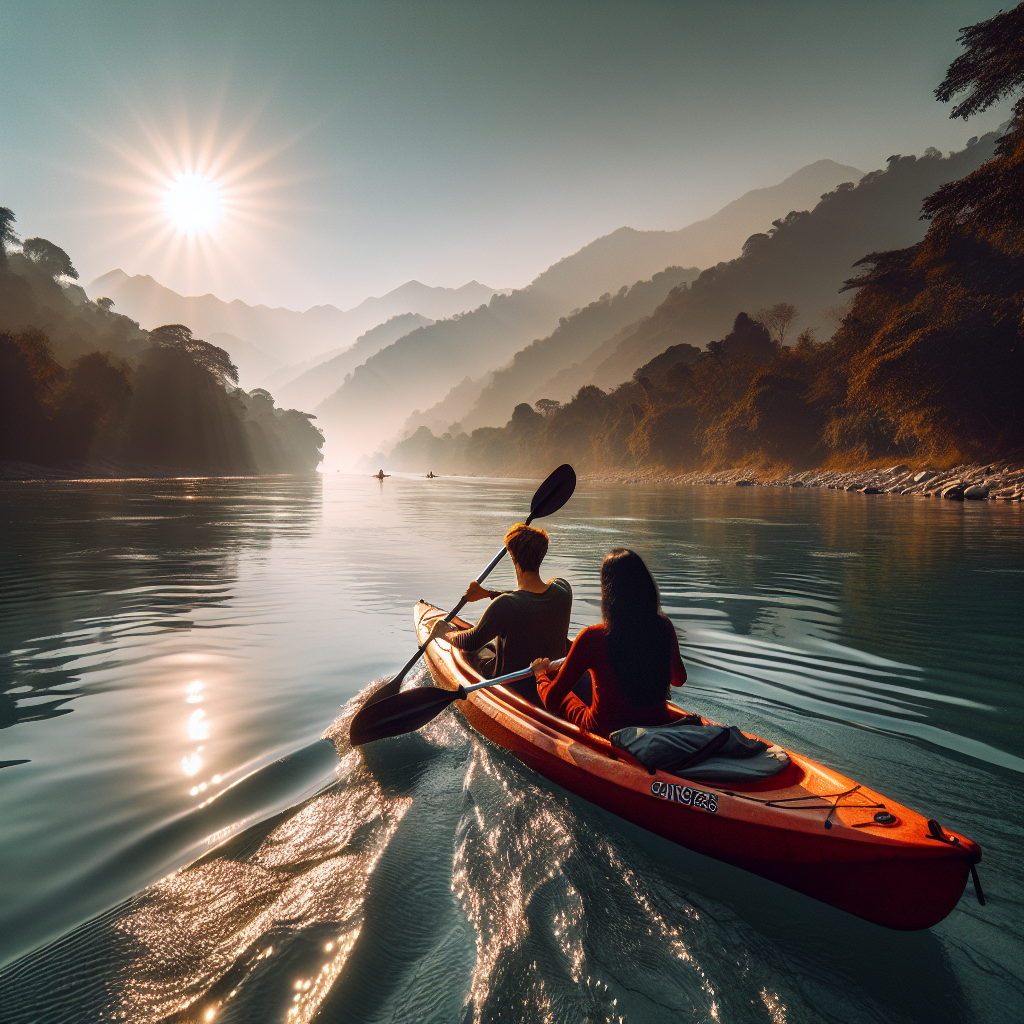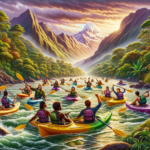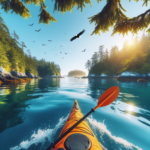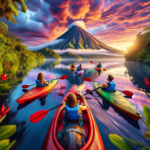Kayaking in Ganges River, India
Introduction to Kayaking
Kayaking is an exhilarating outdoor activity that has gained immense popularity worldwide. It offers a unique blend of adventure, exercise, and a chance to connect with nature. Whether you’re navigating through serene lakes, challenging river rapids, or exploring coastal waters, kayaking provides a thrilling experience that appeals to both beginners and seasoned paddlers. The sport’s versatility and accessibility make it a favorite among outdoor enthusiasts.
In this article, we will spotlight the unique features of kayaking in the Ganges River, India. This iconic river, steeped in history and cultural significance, offers a kayaking experience like no other. From its diverse landscapes to its spiritual ambiance, the Ganges River is a fantastic destination for kayaking enthusiasts looking for a blend of adventure and cultural immersion.
What makes kayaking in the Ganges River truly unique is the combination of natural beauty and cultural richness. Paddlers can enjoy breathtaking views of the Himalayas, lush forests, and ancient temples along the riverbanks. The Ganges River also offers a range of kayaking experiences, from tranquil stretches to challenging rapids, catering to all skill levels.
Join us as we explore the various aspects of kayaking in the Ganges River, India. We’ll cover everything from the best spots and conditions to safety regulations and environmental considerations. Whether you’re planning your first kayaking trip or looking for a new adventure, this guide will provide you with all the information you need to make the most of your kayaking experience in the Ganges River.
Overview of Kayaking in Ganges River, India
The Ganges River, known as the Ganga in India, is one of the most revered and significant rivers in the world. It originates from the Gangotri Glacier in the Himalayas and flows through the northern plains of India before emptying into the Bay of Bengal. The river’s geography is diverse, featuring everything from mountainous terrains to fertile plains, making it an ideal location for various water sports, including kayaking.
The climate along the Ganges River varies significantly depending on the region. In the upper reaches near the Himalayas, the weather is cooler and more temperate, while the lower plains experience a tropical climate with hot summers and mild winters. The best time to visit for kayaking is during the post-monsoon season, from October to March, when the weather is pleasant, and the river’s water levels are optimal for kayaking.
Historically, the Ganges River has been a vital part of Indian culture and spirituality. It is considered sacred by Hindus, who believe that bathing in its waters can cleanse one’s sins. This cultural significance adds a unique dimension to the kayaking experience, as paddlers can witness various religious rituals and ceremonies along the riverbanks.
Accessing the Ganges River for kayaking is relatively straightforward. Major cities like Rishikesh and Varanasi serve as popular starting points for kayaking trips. These cities are well-connected by road, rail, and air, making it convenient for visitors to reach the river. Additionally, several local tour operators offer guided kayaking tours, providing all the necessary equipment and expertise for a safe and enjoyable experience.
Kayaking Conditions in Ganges River, India
The Ganges River offers a variety of water conditions that cater to different kayaking preferences. In the upper reaches near Rishikesh, the river features a mix of calm stretches and challenging rapids, making it a popular spot for both beginners and experienced kayakers. As the river flows downstream, the water becomes more tranquil, offering a peaceful kayaking experience ideal for those looking to relax and take in the scenery.
The weather conditions along the Ganges River can significantly impact kayaking experiences. During the summer months (April to June), temperatures can soar, making it less ideal for kayaking. The monsoon season (July to September) brings heavy rainfall, which can lead to high water levels and strong currents, posing challenges for kayakers. The post-monsoon season (October to March) is considered the best time for kayaking, with moderate temperatures and stable water conditions.
Tides and water currents in the Ganges River vary depending on the region and season. In the upper reaches, the river’s flow is more rapid due to the steep gradient, creating exciting rapids for adventurous kayakers. In contrast, the lower plains feature slower currents, providing a more relaxed kayaking experience. It’s essential for kayakers to be aware of these conditions and choose their routes accordingly.
Environmental factors such as water quality and visibility can also affect kayaking in the Ganges River. While the river is generally safe for kayaking, it’s advisable to check local conditions and avoid areas with heavy pollution or poor water quality. Additionally, kayakers should be mindful of local wildlife and natural habitats, ensuring they do not disturb the ecosystem while enjoying their adventure.
Top Spots for Kayaking in Ganges River, India
Rishikesh is undoubtedly one of the top spots for kayaking in the Ganges River. Known as the “Yoga Capital of the World,” Rishikesh offers a unique blend of spiritual ambiance and adventure sports. The stretch of the river near Rishikesh features a mix of calm waters and thrilling rapids, making it suitable for kayakers of all skill levels. The best time to kayak here is during the post-monsoon season when the weather is pleasant, and the water levels are optimal.
Another popular spot for kayaking is Varanasi, one of the oldest continuously inhabited cities in the world. Kayaking in Varanasi offers a unique cultural experience as paddlers can witness the daily rituals and ceremonies performed along the ghats (riverfront steps). The calm waters of the Ganges in Varanasi make it an ideal location for beginners and those looking to soak in the spiritual atmosphere. Early mornings and late afternoons are the best times to kayak here, avoiding the midday heat.
For those seeking a more challenging experience, the stretch of the Ganges near Devprayag is an excellent choice. Devprayag is where the Bhagirathi and Alaknanda rivers merge to form the Ganges, creating a series of exciting rapids. This spot is ideal for experienced kayakers looking for an adrenaline rush. The best time to visit is during the post-monsoon season when the water levels are high, and the rapids are at their most thrilling.
Lastly, the Sundarbans region, where the Ganges meets the Bay of Bengal, offers a unique kayaking experience through mangrove forests and deltaic landscapes. This area is rich in biodiversity, and kayakers can spot various wildlife, including the famous Bengal tiger. The best time to kayak in the Sundarbans is during the winter months (November to February) when the weather is cool and dry, providing ideal conditions for exploring this unique ecosystem.
Safety and Regulations
Safety is paramount when kayaking in the Ganges River, and it’s essential to adhere to local regulations and guidelines. The Indian government and local authorities have implemented various safety measures to ensure the well-being of kayakers. These include mandatory life jackets, helmets, and other safety gear. It’s crucial to follow these regulations and ensure that all equipment is in good condition before embarking on a kayaking trip.
In addition to wearing appropriate safety gear, kayakers should be aware of their skill level and choose routes that match their experience. Beginners should stick to calmer stretches of the river, while experienced paddlers can tackle more challenging rapids. It’s also advisable to go kayaking in groups or with a guide, especially in unfamiliar areas, to ensure safety and assistance in case of emergencies.
Emergency situations can arise while kayaking, and it’s essential to be prepared. Carrying a first aid kit, a whistle, and a waterproof communication device can be lifesaving in case of accidents or injuries. Additionally, kayakers should familiarize themselves with basic rescue techniques and know how to handle common emergencies such as capsizing or getting caught in strong currents.
Local tour operators and guides play a crucial role in ensuring the safety of kayakers. They are well-versed in the river’s conditions and can provide valuable insights and assistance. It’s highly recommended to book guided tours, especially for those new to kayaking or unfamiliar with the Ganges River. These tours often include safety briefings, equipment checks, and expert guidance, ensuring a safe and enjoyable kayaking experience.
Amenities and Accommodations
The Ganges River region offers a range of amenities to cater to kayaking enthusiasts. Several rental facilities provide high-quality kayaks, paddles, and safety gear, making it convenient for visitors who do not have their equipment. Additionally, local tour operators offer guided kayaking tours, providing all necessary equipment and expert guidance for a safe and enjoyable experience.
Accommodation options along the Ganges River are diverse, catering to different preferences and budgets. In popular kayaking spots like Rishikesh and Varanasi, visitors can find everything from budget guesthouses to luxury hotels. For those seeking a more immersive experience, camping sites along the riverbanks offer a unique opportunity to connect with nature and enjoy the serene surroundings.
In addition to kayaking, the Ganges River region offers various recreational activities for visitors. In Rishikesh, adventure enthusiasts can indulge in activities like white-water rafting, trekking, and bungee jumping. Varanasi, on the other hand, offers a rich cultural experience with its ancient temples, vibrant markets, and spiritual ceremonies. These activities provide a well-rounded experience for visitors, ensuring there’s something for everyone.
For those looking to relax and rejuvenate, several wellness retreats and yoga centers are located along the Ganges River. These centers offer yoga classes, meditation sessions, and Ayurvedic treatments, providing a perfect balance to the adventurous kayaking experience. Whether you’re seeking adventure, culture, or relaxation, the Ganges River region has something to offer for every type of traveler.
Environmental Considerations
Preserving the natural habitats and wildlife along the Ganges River is of utmost importance. Kayakers should practice eco-friendly kayaking to minimize their impact on the environment. This includes avoiding littering, using biodegradable products, and respecting local wildlife. By following these practices, kayakers can help preserve the river’s natural beauty for future generations.
Several conservation efforts and local projects are in place to protect the Ganges River and its ecosystem. Organizations like the Ganga Action Plan and Namami Gange are working towards cleaning and rejuvenating the river. Visitors can support these efforts by participating in local clean-up drives, donating to conservation projects, or simply spreading awareness about the importance of preserving the Ganges River.
Eco-friendly kayaking practices also involve being mindful of water usage and avoiding activities that can harm the river’s ecosystem. For example, kayakers should avoid using soaps or detergents in the river and refrain from disturbing natural habitats. By being conscious of their actions, kayakers can contribute to the conservation of the Ganges River and its diverse ecosystem.
Engaging with local communities and learning about their efforts to protect the river can also enhance the kayaking experience. Many local communities along the Ganges River have a deep connection with the river and are actively involved in conservation efforts. By supporting local businesses and participating in community-led initiatives, visitors can contribute to the sustainable development of the region.
Highlights
When comparing kayaking in the Ganges River with other popular kayaking destinations, several unique features stand out. The Ganges River’s rich cultural and spiritual significance sets it apart from other locations. Paddlers can witness ancient rituals, ceremonies, and festivals along the riverbanks, providing a unique cultural experience that is hard to find elsewhere.
The biodiversity along the Ganges River is another highlight. From the Himalayan foothills to the Sundarbans delta, the river supports a wide range of flora and fauna. Kayakers can spot various wildlife, including river dolphins, crocodiles, and numerous bird species. This diverse ecosystem adds an element of excitement and discovery to the kayaking experience.
Geographically, the Ganges River offers a variety of landscapes, from mountainous terrains to fertile plains and deltaic regions. This diversity provides a range of kayaking experiences, from challenging rapids to serene stretches of water. The river’s changing landscapes ensure that kayakers can enjoy different types of adventures, catering to various preferences and skill levels.
Historically, the Ganges River has been a vital part of Indian civilization for thousands of years. Its significance in Hindu mythology and its role in shaping the culture and traditions of the region make it a unique destination for kayaking. Paddling through the Ganges River allows visitors to connect with this rich history and gain a deeper understanding of India’s cultural heritage.
FAQ Section
- What is the best season to go kayaking in the Ganges River? The best season for kayaking in the Ganges River is during the post-monsoon season, from October to March, when the weather is pleasant, and water levels are optimal.
- Are there beginner-friendly spots for kayaking in the Ganges River? Yes, spots like Varanasi and the calmer stretches near Rishikesh are ideal for beginners due to their tranquil waters.
- What should I bring for a kayaking trip in the Ganges River? Essential items include a life jacket, helmet, first aid kit, waterproof communication device, sunscreen, and appropriate clothing.
- Are kayak rentals available, and what are the costs? Yes, kayak rentals are available in popular spots like Rishikesh and Varanasi. Costs vary but generally range from INR 500 to INR 1500 per day.
- How can I participate in local conservation efforts? Visitors can join local clean-up drives, donate to conservation projects, or support eco-friendly businesses along the river.
- Are guided kayaking tours available, and what do they cover? Yes, guided tours are available and typically include equipment rental, safety briefings, and expert guidance on navigating the river.
- What safety measures are in place for kayaking in the Ganges River? Mandatory safety gear includes life jackets and helmets. It’s also recommended to kayak in groups or with a guide and carry a first aid kit and communication device.
Final Thoughts
Kayaking in the Ganges River, India, offers a unique blend of adventure, culture, and natural beauty. From the thrilling rapids near Rishikesh to the serene waters of Varanasi, the Ganges River caters to all types of kayakers. The river’s rich cultural significance and diverse ecosystem make it a premier destination for kayaking enthusiasts.
It’s essential to respect local guidelines and conservation efforts while kayaking in the Ganges River. By practicing eco-friendly kayaking and supporting local initiatives, visitors can contribute to preserving this iconic river for future generations. The Ganges River’s unique combination of adventure and cultural immersion makes it a must-visit destination for anyone passionate about kayaking.
In conclusion, kayaking in the Ganges River is an unforgettable experience that offers something for everyone. Whether you’re seeking adventure, cultural enrichment, or a peaceful escape into nature, the Ganges River has it all. So pack your gear, respect the local environment, and get ready to explore the beauty and thrill of kayaking in the Ganges River, India.
We hope this guide has provided you with valuable insights and inspiration for your next kayaking adventure. Happy paddling!









